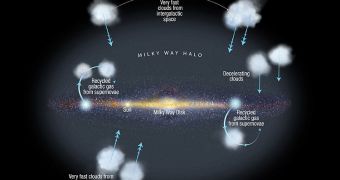For quite some time now, experts have been trying to determine the source of excess gas that helps the Milky Way keep on producing new stars, even if the galaxy is more than 9 billion years old. A new study indicates that the chemical originates in the galactic halo.
The team behind the investigation is quick to point out that not all gas required for stellar formation in our galaxy comes from clouds in the halo, but says that a large amount of molecular hydrogen gas is made available from that source.
What is especially interesting about this new study is that it revealed the existence of three high-velocity clouds (HVC) in the halo, which orbit around the Milky Way at great speed. As they spin, our galaxy's gravity is pulling material out of them at a constant pace.
The hydrogen is then used to create new stars in stellar nurseries, replenishing the Milky Way's dwindling stock. Were it not for these mechanisms, entire galaxies would now be composed of white dwarfs and similar, small-mass stars.
What is also interesting is that the recycling mechanism recently discovered in all galaxies puts some of the gas back in the halo, through powerful nova and supernova explosions. Additionally, heavier elements are sent out as well, although some escape the halo and move on in intergalactic space.
The new investigation was carried out by experts at the University of Notre Dame. They gained access to the Cosmic Origins Spectrograph and the Space-Telescope Imaging Spectrograph instruments aboard the NASA/ESA Hubble Space Telescope for the study, Space reports.
“The first part of the study was to pinpoint the distance of gas clouds. For this, we need stars,” lead study scientist Nicolas Lehner explains. He conducted the study with UND colleague Christopher Howk; together they analyzed 28 randonly-selected stars.
The stars were used as backlight as the team was looking for HVC signatures. “As the light comes from the star to us, it's going to go through the gas cloud,” Lehner explains. By using this method, the team was able to identify the wispy structures.
The three clouds the team discovered are reportedly sufficiently large to support stellar formation in the galaxy. Details of the research appear in the November 18 issue of the top journal Science.

 14 DAY TRIAL //
14 DAY TRIAL //